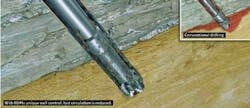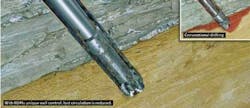Jeremy Beckman
Editor, Europe
Two papers presented this year at the SPE/IADC conference in Amsterdam highlighted the latest initiatives in extended-reach drilling (ERD) offshore. Both outlined the challenges in drilling wells from shore to access outlying reservoirs of nearshore fields.
One paper, by authors from ExxonMobil and Exxon Neftegas, examined the new design that led to a new world record measured depth for an ERD well of 12,376 m (40,604 ft) on the Chayvo field offshore eastern Russia, including a reach of 11,371 m (37,306 ft). This is the latest in a series of ERD wells drilled into the Sakhalin-1 offshore fields, using the land rig Yastreb. The other paper presented findings from a new project based on the Reelwell Drilling Method, which targets much longer ERD wells sections.
Well-path issues
The first extended reach wells on Chayvo were drilled in 2003 from a near-coast location on Sakhalin Island. In 2011, the Yastreb returned to the Chayvo onshore well site for a new campaign.
Z-44 was the first well to target Chayvo's Zone 16 reservoir. ExxonMobil planned a total of four oil producers from the existing onshore wellpad, taking a horizontal path through the western flank before crossing the axis of the anticline to penetrate the eastern flank. One gas injector would be placed horizontally in the gas cap. Distance to the targets was at the edge of the ERD envelope in terms of measured depth and horizontal reach, with some of the wells' open-hole completion lengths exceeding 3,000 m (9,842 ft).
Other challenges were oil column thickness, thought to be around 20 m (65.6 ft), and the uncertainty range for the vertical position of the oil/water and gas/oil contacts of 4-5 m (13-16.4 ft). Simulation studies suggested the best recovery option would come through placement of horizontal oil producers at mid-oil column vertically, with small tolerance for deviation due to the risk of early gas or water breakthrough.
The campaign team opted for downhole formation pressure-while-drilling tools to minimize vertical position uncertainty, and upgraded Yastreb with equipment that included new 57⁄8-in. drillpipe with a higher torque connection capable of 71,500 ft-lb (9,885 kg/m), and two more shakers. In this case the intention was to eliminate solids control as a limiter for the 17½-in. hole, speeding up drilling of that section by 20%.
Drilling of Z-44 started early in 2012 and was completed late last year. According to the authors, all objectives for Z-44 were accomplished, including the planned formation pressure technique for wellbore positioning, with the pilot 8½-in. hole establishing both the fluid contacts and the oil column thickness. The production hole was successfully placed at mid-oil column. The only significant non-productive event during the entire drilling operation was a stuck pipe in the pilot hole, necessitating a whipstock side track at 8,607 m (28,328 ft) - ExxonMobil's deepest to date, and possibly the deepest ever attempted by the industry.
Taking ERD a step further
In 2011, Reelwell started "ERD beyond 20 km," a joint industry project supported by Petrobras, RWE Dea, Shell, Total, and the Research Council of Norway. The aim is to verify the extreme ERD capability of the Reelwell Drilling Method (RDM), which has been under development since 1994.
RDM has the potential to extend the envelope for ERD because it allows flotation of the drillstring, reducing torque and drag to a minimum, and eliminates the dynamic equivalent circulating density (ECD) gradient as the ECD is screened from the formation. A piston-type arrangement at the drillstring provides optional hydraulic weight on bit.
The study involves an application for an offshore field in an environmentally sensitive area, which may require development from an onshore site. This would call for ERD wells with a record-breaking horizontal displacement of more than 13 km (8 mi) and around 2.4 km (7,874 ft) TVD. The offshore target has various salt domes with an overlying chalk formation, and the planned well has a target MD of almost 16 km (52,500 ft).
For the proposed well, the top section is a conventional design with a 20-in. casing set to 1,000 m (3,281 ft) depth. However, because of excessive torque and drag RDM must be used for the 13½-in. section to 14,000 m (45,931 ft) in "Heavy Over Light" (HOL) mode - this is a feature unique to RDM and denotes a situation where the annular fluid is of higher density than the active fluid inside the drillstring. The same applies to the 9½-in. section to 15,800 m (51,837 ft).
Simulation results suggest the proposed well could be feasibly drilled using RDM to around 16,000 m (52,493 ft) MD; 2,400 m (7,874 ft) TVD with torque values of less than 30 kNm (22,127 lb-ft) and drag values of less than 50 tons. Use of a dual aluminum drillstring in combination with the HOL technique is the main enabler. Drillstring buckling, torque and drag are markedly lower, and casing/liner installations are feasible using conventional flotation techniques.
References
2013 SPE/IADC Drilling Conference, Amsterdam.
"Case history of a challenging thin oil column extended reach drilling (ERD) development at Sakhalin." Authors: Vishwas Gupta, Shea Sanford, ExxonMobil Development Co.; Randall Mathis, Erin DiPippo, Exxon Neftegas; Michael Egan, consultant to ExxonNeftegas.
"Extended reach drilling - new solution with a unique potential." Auhtors: O. Vestavik, Reelwell; M.Egorenkov, Merlin ERD; B. Schmalhorst, RWE Dea; J.Falcao, Petrobras.




